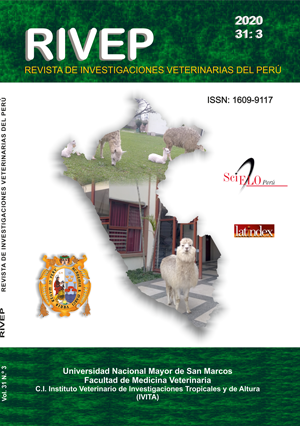Cryptococcus neoformans in faeces of feral and homing pigeons (Columba livia) in Lima, Peru
DOI:
https://doi.org/10.15381/rivep.v31i3.18732Keywords:
Cryptococcus neoformans, pigeon droppings, homing pigeons, feral pigeonsAbstract
The aim of this study was to determine the prevalence of Cryptococcus neoformans in faeces of domestic pigeons (Columba livia) in public places in the city of Lima, Peru, in 2015-2016. Samples of dried faeces were collected from pigeon lofts from captive-bred racing pigeons and from public places for free-living pigeons. The samples were processed and cultured on Sabouraud dextrose agar and incubated at 37 °C up to 10 days. Colonies were identified through macroscopic evaluation, capsule visualization with Indian ink, urease test, sugar assimilation, rapid nitrate reduction, phenol oxidase test and growth on CGB agar. A frequency of 5.16% (16/310) of positive samples for C. neoformans in faeces of both types of pigeons was determined. In the faeces of homing pigeons was 8.89% (16/180), while there were no positive samples in the captive-bred racing pigeons. The stochastic Beta Pert simulation (@Risk 5.5®) a minimum and maximum prevalence for the study of 4.59 and 5.61%, respectively. Cryptococcus neoformans is present in the feces of homing pigeons in the city of Lima, Peru.
Downloads
Downloads
Published
Issue
Section
License
Copyright (c) 2020 Ricardo Timmermann F., Siever Morales-Cauti, Eglinton Villacaqui A.

This work is licensed under a Creative Commons Attribution-NonCommercial-ShareAlike 4.0 International License.
AUTHORS RETAIN THEIR RIGHTS:
a. Authors retain their trade mark rights and patent, and also on any process or procedure described in the article.
b. Authors retain their right to share, copy, distribute, perform and publicly communicate their article (eg, to place their article in an institutional repository or publish it in a book), with an acknowledgment of its initial publication in the Revista de Investigaciones Veterinarias del Perú (RIVEP).
c. Authors retain theirs right to make a subsequent publication of their work, to use the article or any part thereof (eg a compilation of his papers, lecture notes, thesis, or a book), always indicating the source of publication (the originator of the work, journal, volume, number and date).










